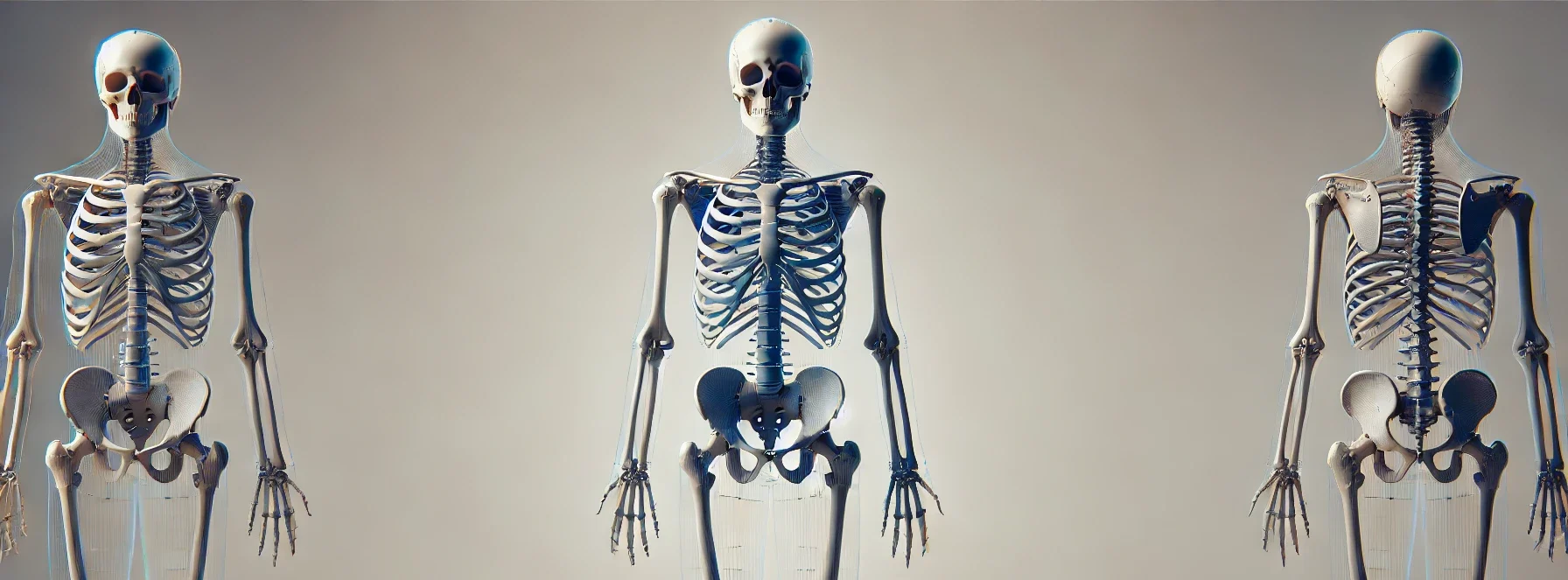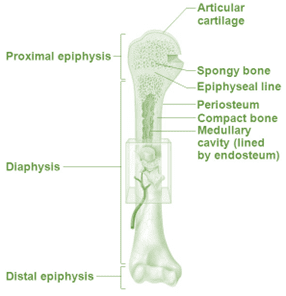- Bones are rigid organs that form part of the endoskeleton of vertebrates.
- They function to move, support, and protect the various organs of the body, produce red and white blood cells, and store minerals.
- Bone tissue is a type of dense connective tissue. Bones come in a variety of shapes and sizes and have a complex internal and external structure.
Composition and Properties of Bone
-
Matrix Material:
- Organic Components: Primarily collagen, which provides tensile strength and flexibility.
- Inorganic Components: Primarily calcium phosphate, which provides hardness and resistance to compression.
-
Bone Cells:
- Osteoblasts: Cells responsible for bone formation.
- Osteocytes: Mature bone cells that maintain the bone matrix.
- Osteoclasts: Cells involved in the resorption of bone tissue.
This is a sample ad placement!
Structure of Bone
- They are rigid connective tissue organs that make up the skeletal system.
- They are composed of specialized cells, extracellular matrix, and minerals.
- The structure of a bone can be divided into two parts: the macroscopic and microscopic structures.
This is a sample ad placement!
Macroscopic Structure:
-
Diaphysis:
- The long, cylindrical portion of a long bone.
- Composed primarily of compact bone, providing strength and rigidity.
-
Epiphyses:
- The rounded ends of a long bone.
- Mostly made of spongy bone, with an outer layer of compact bone.
-
Metaphysis:
- The region between the diaphysis and epiphysis where bone growth occurs during childhood and adolescence.
- Contains the epiphyseal plate (growth plate) in growing individuals.
-
Periosteum:
- A dense, fibrous membrane covering the outer surface of bones, except at joints.
- Contains blood vessels, nerves, and osteogenic cells essential for bone growth, repair, and nutrition.
-
Endosteum:
- A thin, vascular membrane lining the inner surface of bones, including the medullary cavity and trabeculae of spongy bone.
- Contains osteogenic cells involved in bone growth and repair.
-
Medullary Cavity:
- A hollow space within the diaphysis of long bones.
- Filled with yellow bone marrow, which stores fat and serves as an energy reserve.
Microscopic Structure:
-
Compact Bone:
- Also known as cortical bone, it is dense and forms the outer layer of bones.
- Consists of tightly packed concentric rings called lamellae, surrounding a central Haversian canal.
- Haversian canals contain blood vessels and nerves, providing nutrients and oxygen to the bone cells.
-
Spongy Bone:
- Also known as cancellous or trabecular bone, found mainly in the epiphyses of long bones and the interior of other bones.
- Consists of a network of interconnected trabeculae, creating a porous structure.
- The spaces within spongy bone are filled with red bone marrow, where blood cell production occurs.
This is a sample ad placement!
Functions:
- Support: Bones provide a framework for the attachment of muscles and other tissues.
- Protection: Bones such as the skull and rib cage protect vital organs from injury.
- Movement: Muscles are attached to bones, which act as levers to produce movement.
- Mineral Storage: Bones serve as a reservoir for minerals, particularly calcium and phosphorus.
- Blood Cell Production: The marrow in the cavities of bones is the site of red blood cell production (hematopoiesis).
Bone Growth and Remodeling:
-
Growth:
- They grow in length due to activity at the epiphyseal plate (growth plate).
- It grows in diameter through the addition of bone tissue at the surface.
-
Remodeling:
- A lifelong process where bone tissue is continuously replaced and reshaped.
- Influenced by mechanical stress and hormonal changes.
Types of Bones
-
Long:
- Longer than they are wide, functioning as levers for movement.
- Examples: Femur, tibia, fibula, humerus, radius, ulna.
-
Short:
- Cube-shaped, providing support and stability with little movement.
- Examples: Carpals (wrist bones), tarsals (ankle bones).
-
Flats:
- Thin, flattened shape, protecting underlying organs or providing large surface areas for muscle attachment.
- Examples: Skull bones, scapula, sternum, ribs.
-
Irregular:
- Complex shapes that fulfill various functions, such as protection and support.
- Examples: Vertebrae, sacrum, coccyx, bones of the pelvis (ilium, ischium, pubis).
-
Sesamoids:
- Small, round bones embedded within tendons, helping to reduce friction.
- Example: Patella (kneecap).
This is a sample ad placement!
Health and Disease:
-
Osteoporosis:
- A condition characterized by decreased bone mass and increased susceptibility to fractures.
-
Arthritis:
- Inflammation of the joints, which can affect the surrounding bone structure.
-
Fractures:
- Breaks in the bone often caused by stress or impact.
Thank you for reading from Firsthope's notes, don't forget to check YouTube videos!


